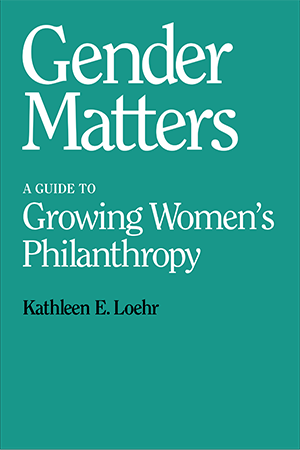
In the past few years, there’s been growing interest in women’s philanthropy. Boston Consulting Group estimates that women’s wealth will constitute 32% of total private wealth by 2020. However, organizations still make critical errors or missteps when dealing with their female constituents. At the end of February 2019, newspapers reported that “Stephen King and his wife donate $1.25M to the New England Historic Genealogical Society” there was incredible outrage from Stephen and Tabitha because the gift was her idea. While the nonprofit isn’t to blame, but rather the newspaper, this misstep is unfortunately not uncommon for many female donors in this day and age. Enter Katherine Loehr’s Gender Matters: A Guide to Growing Women’s Philanthropy that provides a framework to help organizations do a better job cultivating, stewarding and getting to know their female donors and prospects.
Who Should Read This Book?
This book should be read by leadership, gift officers, and ideally everyone in an organization committed to engaging their female constituents. Loehr repeatedly explains throughout the book that the full integration of the entire fundraising apparatus at an organization to be truly effective. No women’s philanthropy program will be effective without buy-in from the entire organization; she cautions against the approach of assigning one person to deal with women’s philanthropy since that historically has failed. But buy-in from leadership is critical as a place to begin reconsidering how organizations work with their women donors and prospects.
Where Does It Take you?
Loehr breaks down the book into four sections: Discover, Dream, Design and Destiny. In the first section, she talks about the importance of understanding women philanthropy. She starts by summarizing recent research from the Women’s Philanthropy Institute at the Lilly Family School of Philanthropy that help explore general differences in women’s philanthropy from men. Then she advocates for organizations to take the time to understand their own specific women constituencies through deep dive into existing data and meaningful conversations with donors and stakeholders.
Then in her Dream section, she advises the need for organizations to create “a compelling vision for building women’s giving to your organization.” Often times, organizations jump from the discover to action without figuring out what the focus and goal will be for their specific organization.
The third part “Design” breaks down actions that individual departments in Advancement can do to build a strong women’s philanthropy program. Loehr explores how prospect research, advancement communications, volunteering, stewardship and other departments, to reaffirm how everyone can influence women’s philanthropy programs in their own specific ways. The last section “Destiny” is about delivery of the new vision of women’s philanthropy along with metrics and accountability. The entire organization should be working to making the “Dream” a reality.
Is It Worth the Purchase Price?
Yes, this book is well worth the cost of $39.50 or $29.50 (CASE member price). Loehr provides a thoughtful and detailed framework for nonprofits to create successful women’s philanthropy programs particular to one’s organization. She makes an effective case about how “best practices” and the history of how organizations use “fundraising practices that either turn off women or gain only minimal support from them.” “One size fits” all does not work for women.
While she purposefully avoids providing a how-to, her framework approach is quite detailed, looking at all stages of the process. At times it could be a little repetitive but the overall effect should be a great tool for organizations looking to make real changes to engage their female stakeholders and donors.
Change is not going to happen from one person within the organization; it must be incorporated into everyday actions. Her chapter on Dream is particularly important since it advocates that organizations need to focus on particular goals; changing everything at once is not feasible.
In particular her breakdown of how individual departments can contribute to the larger vision is particularly effective in showing how antiquated views of philanthropy and women constituencies work their way into all processes, such as what data is stored in the donor database or how organizations thank their donors (i.e. Tabitha King’s story is not as uncommon as one would hope).
Realistically, what she advocates is what all effective fundraisers should be doing: listening and responding to their donors and stakeholders. While the book focuses on women’s philanthropy, it may be a good framework to begin talking about how organizations can better get to know and cultivate other donor constituencies, such as minorities, LGBTQ communities as well.
Overall, Loehr explains that organizations must make the difficult choices to incorporate women’s philanthropy into their entire organization. She makes a compelling case that the future of philanthropy is female.
